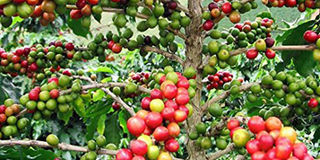How red cherries give more than dried coffee

Red coffee cherries may earn you more than the processed beans. File photo.
What you need to know:
When coffee is sold instantly from the garden, it removes storage costs and risks, it also eliminates labour costs related to drying and security as well as other costs such as spending on tarpaulins, writes George Katongole.
When coffee is sold instantly from the garden, it removes storage costs and risks, it also eliminates labour costs related to drying and security as well as other costs such as spending on tarpaulins, writes George Katongole
Increased demand for coffee by wet mills is driving innovations among farmers. Experts explain that farmers can still earn top dollar from coffee harvests with limited hustle.
Red cherries
According to Ugacof, who are certified coffee exporters, harvesting red cherries pays more than traditional drying. For quality purposes they prefer to buy red cherries. According to Joseph Ruyombo, an extension worker with Ugacof, red cherries can easily be examined for quality as they arrive at the wet mill. This enables the buyers to sell the right coffee quality to the world market.
Ugacof’s approach has given birth to several washed Robusta plants in Buikwe District who benefit from the hundreds of smallholder coffee farmers in the area.
Coffee cherry is sweet and sugary with lots of flavour. They are usually identified when they turn red upon ripening. According to Ruyombo, they are a great for cupping in the lab with a fine aroma.
Regulatory body, Uganda Coffee Development Authority (UCDA), also encourages farmers to harvest ripe coffee cherries among the good agricultural practices.
Picking coffee
To get red cherries, picking is the preferred method of harvesting to stripping.
According to Ruyombo, four kilogrammes of red cherries can yield two kilogrammes of kibooko after drying. The same amounts to one kilogramme of kase.
“The math is simple. The only effort one needs is during picking but you end up saving a lot of time,” Ruyombo explains.
This cumbersome process begins after green, unripe cherries from Arabica coffee plants have turned red, signalling pristine harvesting conditions.
Ruyombo says this is quite tiresome but rewarding. Some farmers though still prefer stripping but he explains that bad cherries, some still young can be harvested leading to unwanted losses.
After picking, the coffee should be sold to a wet mill as fast as possible not exceeding 48 hours.
“Normally, for coffee that is harvested in the morning should be delivered in the evening to the wet mill,” says Ruyombo.
In the event the farmer fails to deliver, Ruyombo advises the cherries should be laid on tarpaulins where no heat can be generated or be kept in water, which he recommends as the best option.
When coffee is sold instantly from the garden, it removes storage costs and risks, it also eliminates labour costs related to drying and security as well as other costs such as spending on tarpaulins.
“This means a farmer earns more with several costs eliminated,” Ruyombo, a coffee expert, says.
In terms of money, the rewards are immense. Ugacof buys a kilogramme at the wet mill for Shs1,100 while most middlemen buy between Shs900 and 1,000. But considering the fact that exporters are paid between Shs4,300 and Shs5,000 for a kilogramme of kase, it is more beneficial to sell red cherries. Coffee drying not only piles up costs, it comes with related challenges to the quality of the bean. According to Ruyombo, there are high chances of moulding which brings the risk of aflatoxins.
Challenge
But getting red cherries is dependent on the availability of wet mills. These are however not present in most parts of the country.
In Kiganda Sub-county in Mubende District, for instance, Patrick Kwanuka, who grows coffee on most of his 10 acres of land says they only have the option of selling dried coffee.“For all the time I have grown coffee, I have never sold red cherries,” the 70-year-old says.
Most of the coffee in the area is bought either by middlemen or processors who remove the husks before they can sell to other buyers such as Ugacof. Other buyers including Starbucks still cherish sun dried coffee although they encourage meticulous handpicking of optimally ripened cherries. In some areas, though, changing farmer’s perceptions on coffee picking rather than stripping is limiting the extent of obtaining red cherries.
“But if farmers embrace picking red cherries, a lot of obstacles in the coffee value chain can be overcome. There is an urgent need to have more wet mills across the country in order to be able to sell uncompromised coffee on the world market,” Ruyombo sums up.




